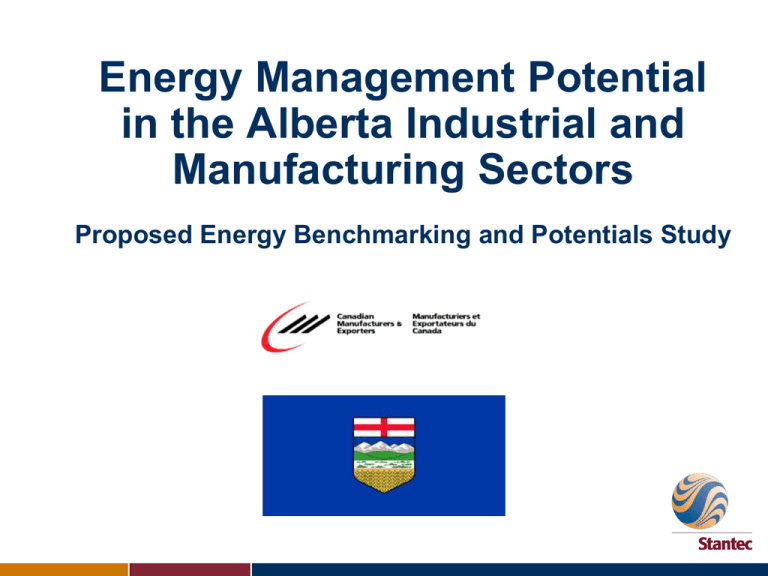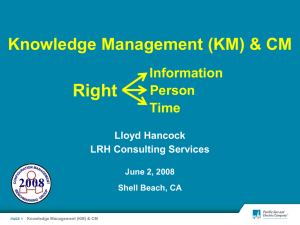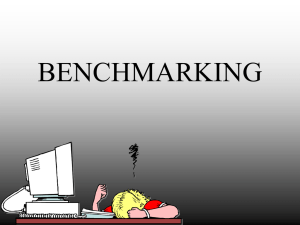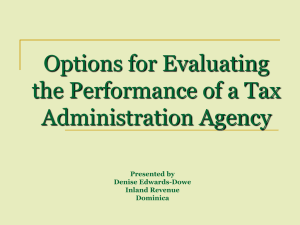PPT - Alberta Energy Efficiency Alliance
advertisement

Energy Management Potential in the Alberta Industrial and Manufacturing Sectors Proposed Energy Benchmarking and Potentials Study About this Presentation • Experience in Other Provinces: – Drivers in other provinces • Overview of three key project streams: – Benchmarking of energy use and implementation of best practices – Energy savings potential – Implementation of opportunities • Value proposition for Alberta Main Study Drivers in NB, NS and ON • Increase competitiveness of industrial sector • Identify opportunities for cost reduction and increased energy efficiency • Define scale of potential savings in industrial energy efficiency savings and GHG in province • Provide necessary information for utilities and government to develop energy efficiency programs and platforms Overview of Project Streams Energy Management STREAM 1: Benchmarking: Energy Use, and Technical and Management Best Practices Define Current Market Penetration of Best Practices and Technologies STREAM 2: Energy Management Potential Analysis Identify Opportunities STREAM 3: Increase Adoption of Technologies and Best Practices STREAM 1: Energy Benchmarking • Define current energy efficiency performance • Define baseline performance to measure future performance against • A continuous improvement tool • Compare plant performance with rest of industry’s performance • Identifies areas for potential improvement The CME/Stantec/Marbek Benchmarking Approach • Best practice and field tested • Three pronged approach – Energy use performance – Technical best practices – Management best practices • It tells you: – How you are doing – Why you are where you are Bottom Up End-Use Analysis Using Robust Excel Model Steam Electricity Wind -Power Hydro-electric Co-generation Biomass Self Generation RPP Compressors Refrigeration Motors Natural Gas Propane Fans & Blowers Conveyors Pumps Boilers Furnaces Comfort Heat Process Lighting Engines Survey Inputs are Mapped into End-Uses for Each Plant Technical Best Practice Analysis Penetration of Applicable Technical Best Practices by Energy End-use Category 100% 90% Average % Implemented of Applicable Technical Best Practices 80% 70% 70% 67% 65% 58% 60% 54% 50% 40% 42% 40% 36% 30% 20% 10% 0% Process Process Direct Heat Indirect Heat Process Cooling Process Motors & Motor-driven Process Other Energy End-use Category Comfort System-level Overall % Impl of Appl Tech BPs Management Best Practice Analysis Energy Management Scores by Category 100% Average Energy Management Score (% of maximum achievable) 90% 80% 74% 70% 62% 60% 50% 56% 56% 58% 53% 46% 40% 30% 20% 10% 0% Energy Policy Organisation Skills & Knowledge Information Systems Marketing & Comm. Energy Management Category Planning & Investment Overall Avg Correlation has shown in other studies that a 5% performance improvement possible for every 20% improvement in MBP score. STREAM 2: Energy Management Potentials Typically 4 key outputs for jurisdiction (eg. province) – Baseline energy use profile – Reference case projection (specified analysis period) – Economic energy management potential – Achievable (market) energy management potential Identify economic and achievable potential for energy savings (provincial and sector) Stream 3: Increase Adoption of Best Practices and Technologies • Develop strategies and mechanisms to advance implementation of identified opportunities • Specific and customized for jurisdiction • Examples: – NB: Program concepts leading to design and delivery of Industrial Energy Efficiency Program (Efficiency NB) – NS: Design and deliver outreach events (CME), information for industrial program (NS Power) – ON: Framework for integrated programs and platforms delivered by CME, utilities and government Summary of Key Outputs • Public Domain – Province wide energy benchmarking results (by sector if sample size large enough) – Province and sector specific energy management potential results • Confidential – Plant/company specific reports Trends in Alberta Federal Regulatory Framework for Industrial Air Emissions: short-term emission intensity reduction targets for GHG emissions (come into force in 2010) Some sectors are energy and GHG intensive, e.g.: energy use in Canada’s upstream oil and gas industry increased by 89% over 1990-2004; an increase in total energy intensity of 18% (1.4% per year). Structural shift towards more energy-intensive oil-sands and the increased energy needs associated with extracting resources from depleted conventional reserves. Energy Benchmarking in Canada • • • • Refineries (2001 survey-5 plants in Alta) Open Pit Mining (based on 2000 data) Cement All industry: New Brunswick, Nova Scotia, Ontario (in progress) • Other sectors funded by OEE Value Proposition for Utilities and Government • Robust empirical foundation for policy and program development • Prioritize targeting of key industry energy end-uses and energy efficiency measures for investments Value Proposition for Industry • Supports Management Commitment – A quality management practice that encourages continuous improvement. • Supports Planning and Action. Participating companies receive: – a confidential evaluation of their company/plant management & technical practices, – comparison of their corporate and facility energy management performance to other facilities in their sector – recommendations on where they should be focusing efforts for the best economic return in energy savings Study Coverage • In-depth analysis to cover about 70% of industrial energy use - balance based on extrapolation • All fuels (including renewables and alternatives) • Typically: – 7 to 10 sub-sectors – 15 to 20 remote surveys per sector – 8 to 10 on-site assessments per sector Study Roll Out: Energy Benchmarking • Recruitment of companies/plants • Design and apply remote survey tool • Design and apply on-site assessment protocol • High degree of oversight to ensure QC • Analyze data • Generate benchmark outputs Study Roll Out: EM Potentials • Determine base year and study period • Acquire utility sales data by NAICS code • Build base year, end-use profile of energy use • Construct reference case and savings scenarios. Funding Required • Estimated: $800 K to $ 1,200 K • 12 - 18 months • Estimated 70 - 90 on-site assessments and 150 - 200 remote assessments







